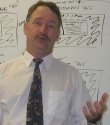|
LUCK, as you have likely heard, happens most often
when opportunity meets up with preparedness.
All professions, of which sales may well be the oldest, have many things in common. The
the most common for all professions is the understanding and use of effective processes. Knowing
where you want to get to, and getting there, can be two very different things. Connecting them requires
the professional salesperson to know where and how to start a successful presentation. It is right
there, at the beginning, that most problems with closing can be found and fixed.
What are the secrets to a strong opening?
- Think like the buyer by mentally putting yourself in their situation.
- Answer these key buyer questions, in this order:
- Who are you?
- Why are you there (what are you selling)?
- What's in it for them?
- Why should they believe or trust you?
- How long will this take?
- What decisions do you expect them to make?
- Confirm that they understand and are willing to move forward with the presentation.
By thinking like your buyer, you should be able to anticipate questions and be more prepared
in your presentation.
Dealing with the key buyer questions is also an essential part of moving effectively to an
opportunity to close. More than that, it is an example of the ABC's
of closing -- Always Be
Closing. Every sales situation consists of several decision points.
Each of these points requires the salesperson and the buyer to come to an agreement before moving
on. It may be agreeing on color, price, or referrals, OR it may
be agreeing on whether you can ask for the sale. It is this sixth key buyer question at the
very beginning that most often derails closing the sale, before it ever gets started!
Our Client Driven program identifies the EIGHT communication skills needed in selling,
the FOUR stages of the sales process, and the TWENTY steps within the sales process.
By ensuring an understanding of the decision process and the communication skills, we
are able to help our clients build an effective set of techniques and behaviours
to assist their clients in making the right, informed, buying decision.
This article is focused on the process, as that is the most likely area to create barriers
to closing. To truly make the most of the process, our formal training, coaching and
facilitation programs begin with defining and developing the skills that are
necessary to succeed throughout the process.
|
REVIEW OF CLOSING
This selling skill occurs throughout the sales process. It is essential
to close on each point before you can move on to the next.
To try setting the stage for Closing early in your presentation, consider the
difference in how Expectations are affected in the following examples.
Example 1:
As a person interested in selling, you will be reading this article in which we will
be reviewing some skills, the sales process, and specific sales behaviours that
might improve your closing ratio. You are under no obligation to buy any of this, to
contact us to sign up for our professional programs, or to go back and use any of
these techniques.
WHILE TRUE, none of this helps to set the stage for success. Not for you, and not
for sales.org.
Example 2:
In this article we are going to begin to identify selling skills, the sales process,
and specific behaviours that can improve your closing ratio. By reading this you have
shown us that this is important to you, so we'll be concentrating on quick solutions
you can take from the article, use now, and increase your sales success.
We know that our first sale to you is having you commit to using the improved skills
and behaviours we present to you here.
All that we ask in return for providing this
information to you without an obligation is that you practice and use these tips, write
to us with your success stories, and tell everyone you know about the value our
Client Driven sales program has provided you.
It is only after you've experienced the success that these techniques WILL produce, that
you'll want to consider taking our entire program. At time please contact us to review
what is involved in enrolling in our programs.
The table below is a planning guideline to help you use DIRECTION as a process to
set the stage more effectively. You have our best wishes for GREAT SELLING SUCCESS!
©1996 Geoff Davidson

Geoff Davidson is a principal in sales.org,
a Canadian-based consulting company specializing in sales, training, & organizational effectiveness.
|
